Salisbury (Sarum) Probus Club
Sarum Probus Club is an organisation for retired men living in the Salisbury Area.
Previous Meetings 2024
Salisbury Rugby and Spitfire Fame -
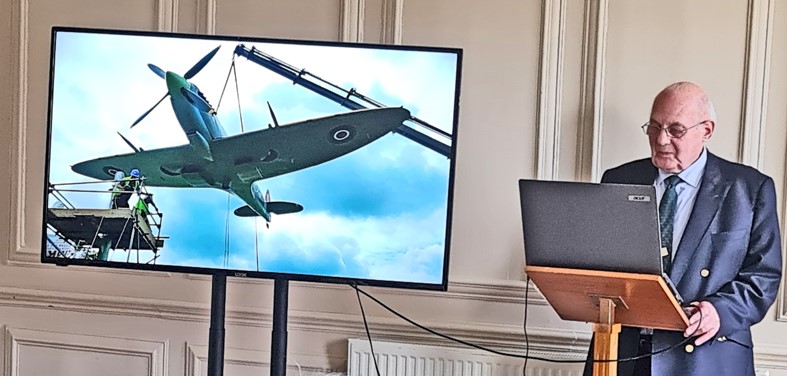
Our club member
Alan Frener treated us to a fascinating and moving story of Salisbury
fame. As a longstanding coach of Salisbury Rugby Club he and his team of
youngsters were able to welcome
Richard Hill,
member of the 2003 World Champion team, to their Salisbury clubhouse. Hilly
hails from Salisbury and is still a frequent visitor to the club.
The second claim to fame is the, until recently, untold story of the
secret Spitfire factories in the City and its surroundings.
The Club was specially delighted to welcome as a guest Norman Parker,
author of “Secret Spitfires Memorial”
The original home of Spitfire development and manufacture was
Southampton. However, after the first devastating air attacks in September
1940 it was decided to disperse Spitfire production. Salisbury became the
biggest of several places of secret, dispersed production.
Factory number one was next to Salisbury Rugby Ground. It is now marked
out by the Spitfire Memorial just next to Castle Road.
There were factory sites all over town hidden in innocuous buildings .
Each factory worked autonomously producing complete planes. In total about
2500 Spitfires were produced by Salisbury factories. Alan’s presentation
included a wealth of video interviews of those who had played a part in this
highly secretive operation. Husband and wife would not know for years that
each worked in different branches of this secret operation.
The True Story of the African Queen
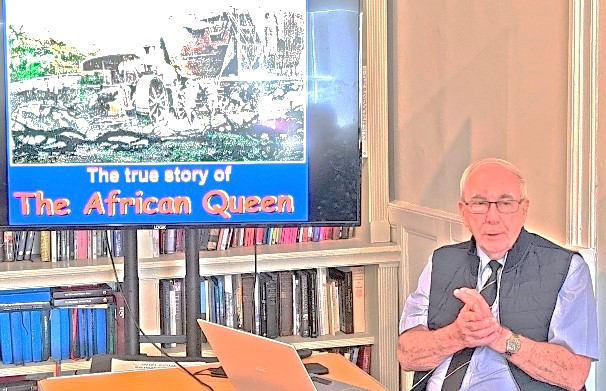
There was first a brief
sketch of German East Africa at the outbreak of WW I, surrounded by
British and Belgian colonies and blockaded by the British Navy.
Background
and Early Strategy: Von Lettow-Vorbeck, a seasoned military officer with
experience in China and German Southwest Africa, took command of the
German colonial forces in East Africa (modern-day Tanzania, Burundi,
and parts of Mozambique) in 1914. His forces were relatively small,
consisting of a few thousand German officers and a larger number of
Askari (African soldiers loyal to Germany). These he taught German
to overcome the linguistic divisions of African tribes and turned
them into a formidable fighting force.
The Germans had established a strong naval
presence on lake Tanganyika with armed ships, including the
notorious gunboat Graf von Götzen.
The British Plan:
The British plan to take control of Lake Tanganyika involved an
extraordinary and audacious feat of engineering and military
planning. Spearheaded by the eccentric British officer Geoffrey
Spicer-Simson and under the command of the Royal Navy, the mission
was to transport two small gunboats, HMS Mimi and HMS Toutou, from
Britain to South Africa and then overland through the jungle to Lake
Tanganyika—a journey of over 10,000 miles.
The
Overland Journey: The transportation of
the boats was a Herculean task. After arriving in South Africa, the
boats were transported by train and ox-cart through some of the most
challenging terrain on the continent, including dense forests and
mountains.
The British contingent
consisted of
28men and
60 tons with a train more than a mile long. The
task
also required hundreds of local labourers, many of them local women who
fetched and carried the enormous amounts of water needed for the steam
engines.
Combat on the Lake:
Once deployed on the lake in late 1915, Mimi and Toutou quickly made
an impact. In a series of daring raids and engagements, they managed
to sink the German ship Kingani in December 1915, and another, the
Hedwig von Wissmann, in February 1916.
Graf von
Götzen, built in 1913, was the most powerful of three
vessels the German Empire used to control Lake Tanganyika during the
early part of the First World War. Her captain had her scuttled
on 26 July 1916 in Katabe Bay during the German retreat from Kigoma.
Refloated, refurbished and renamed MV Liemba, she is now the oldest
“operating” passenger ship in the world. It's been sailing between
Kigoma, Tanzania and Mpulungu, Zambia, since 1915. Kevin was able to
visit her.
End of the Campaign:
Despite the spectacular British feat on the lake Lettow-Vorbeck’s
campaign continued even after the armistice in Europe on November
11, 1918. He finally surrendered on November 25, 1918, upon
receiving news of the armistice from British forces, making his East
African campaign one of the last to conclude in World War I.
Fictionalisation:
The author C S Forester picked up the
extraordinary story of the boat transport and naval engagements and
turned it into a novel. This he revised and republished twice.
In 1951 the book was adapted for the film directed by John
Huston and
produced by Sam
Spiegel. Ever since many stories abound as to where the film was shot and where
the boat dramatized in the film has ended up.
Kevin convinced us that most of the “water scenes” were not shot in
Wareham river but rather in the studio. The boat used in the film was
bought and restored by a German
enthusiast. It is now in the USA.
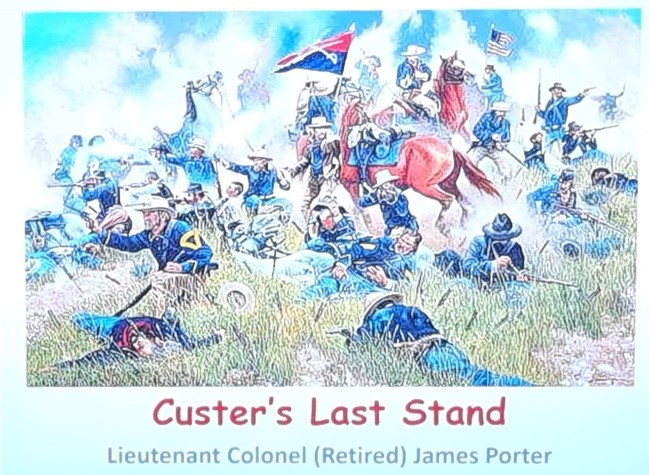
On 10th May 2024 the Club was delighted to welcome back Col. James Porter as speaker of the day. He gave us as meticulously researched account of The Battle of Little Bighorn, commonly referred to as "Custer's Last Stand".
The events chronicled by Col Porter
took place one week before the first centenary of the USA,
on June
25-26, 1876. It was an engagement between the United States Army and
combined forces of Lakota Sioux, Northern Cheyenne, and Arapaho
tribes numbering between 1,500 and 2,000.
Custer’s complete force of 210 got
massacred.
Lt. Col.
Custer, a controversial and ambitious military leader known for his
Civil War exploits, commanded the 7th Cavalry Regiment. During the
Civil war he was acting Major General, a great
self-publicist, as well as a stern disciplinarian. At one stage of
his career, he had
12 defectors summarily executed. He was
admired by many but certainly not
all.
Disregarding orders to wait for reinforcements, Custer aimed to surprise
the Indian encampments. His troops, however, were met by a vastly
superior force of over 2,000 Native American warriors. Unbeknownst
to Custer, he was facing one of the largest gatherings of Native
American fighters of the Plains Indian Wars.
The battle began when Custer divided his regiment into three battalions,
aiming to attack from multiple directions. Two of the battalions,
led by Major Marcus Reno and Captain Frederick Benteen, were soon
overwhelmed and forced to take defensive positions. Custer and his
immediate command of around 210 men advanced and were encircled by
the warriors.
The exact details of Custer’s last moments are unclear due to the lack of
survivors from his battalion. However, it is known that Custer and
all of his men were killed in an intense battle lasting less than an
hour. The Native American forces, led by prominent leaders including
Crazy Horse and Chief Gall, achieved a stunning victory.
The aftermath of the Battle of the Little Bighorn had significant
consequences. It shocked the American public and government, leading
to a harsher military strategy against Native American tribes.
The Holy Grail in America –

On June 16th the Probus Club of Sarum was
delighted to welcome Richard Huntley as speaker of the day. With a
richly illustrated presentation he led us through the history and
legends surrounding the Templars, pre-Colombian exploration of North
America and possible Scottish connections.
Another element often linked to the Templar and
Scottish presence in North America is the Newport Tower: Located in
Rhode Island, the Newport Tower is a round stone structure whose origins
are debated. Some claim it is evidence of pre-Columbian European
exploration, including by the Norse or Scottish-Templar explorers.
Proponents of the Templar theory suggest the tower was built by
Sinclair’s expedition or by the Templars themselves. However, mainstream
historians typically date the tower to the colonial period, around the
17th century. At the centre of all these theories and legends is the
idea that the Templars had found the Holy Grail during their occupation
of Jerusalem and managed to spirit it out via Acre and Cyprus to
eventually bring it to North America.
Memories of a Raving Roving Reporter
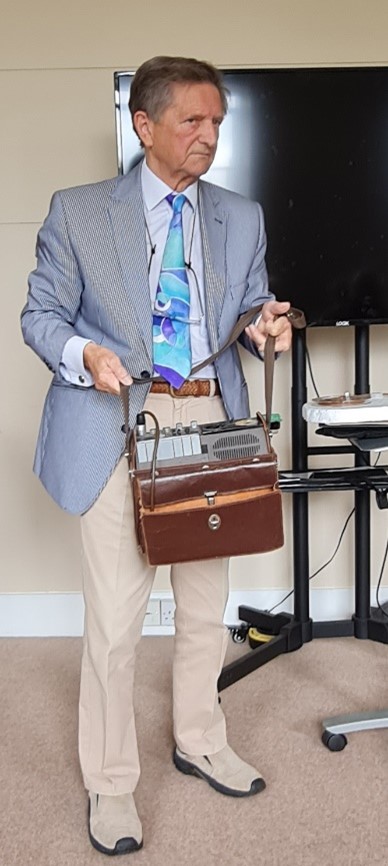
On 12th July the
Probus Club of Sarum was able to welcome back Alan Jones, retired BBC
Radio reporter. This time he entertained us with amazing as well as
hilarious stories from his many years with the BBC.
He warned us, all
his episodes would be about foul-ups and mishaps, many of them due to
the then precarious technical arrangements available to a life radio
reporter.
Alan started
recalling his BBC interviewing experience. He had to face a scary panel
of interviewers. When he was called for a second session the chairman
explained how many different roles the BBC has for young journalists,
from writing the stories to presenting them on TV and Radio. The
chairman concluded: “You have the face for radio”. Thus began a lifelong
BBC career spanning some 24,000 interviews.
In 1990 the provisional west wall of
Portsmouth Cathedral was demolished to restart the construction of the
west end. This marked the resumption of the expansion project that had
been delayed due to the war. Alan was asked to join a senior cleric at
the top of the scaffolding to interview as he dislodged the first brick
and blessed the restart of the project. However, his interviewee was so
terrified of heights that he rushed up like a
Jack in a box, dislodged a single brick and
tried to rush back down the ladder. Alan had to trap him on the ladder
in order to get his life interview.
The event was the
ceremonial opening of a “blue flag beach” in Pool by the Mayor. This was
to be a mock landing of marines in RIBs, led by the nubile, bikini clad
daughter of the mayor. Mock explosions were to go off as they rushed the
beach. As the flotilla approached Alan told the producer to get him on
air. He was told wait!
When they finally
told him to start he had to tell them it was already over. The
instructions through his earphones: “Tell them to do it again”!
On June 10, 1990
Alan was asked to rush to
Southampton Airport because British Airways Flight 5390 from Birmingham
to Málaga had been rerouted for an emergency landing.
Approximately 20
minutes into the flight at an altitude of 17,300 feet, the left cockpit
windshield had blown out and Captain Tim Lancaster being partially
sucked out of the cockpit.
Co-pilot Alastair Atchison took immediate
control of the aircraft. Flight attendants Nigel Ogden and Simon Rogers
acted quickly to hold onto Captain Lancaster's legs, preventing him from
being fully ejected.
Despite the extreme
conditions—wind speeds of over 300 mph, temperatures around -17°C, and
the threat of further decompression—the crew's coordinated efforts kept
Captain Lancaster from being lost.
Without any
technical support Alan was asked to report life on air about this
dramatic event. He had to use paper makers on his portable tape recorder
to cobble together his life report.
Captain Lancaster
suffered frostbite, fractures to his right arm and wrist, and a broken
thumb. Despite the severity of his injuries and the traumatic
experience, he was back on duty after six months.
Drama and
misunderstanding seemed to span a very wide scale of human experience
indeed in Alan’s professional life.Alan was asked to
attend a big leukaemia fund raising even in Swindon and interview the
Mayor. On arrival the receptionist in the glass entry box was stark
nude. When he was led to the press officer in the main hall he was nude
as well. It turned out the fund raisers were the Nudist Sports Club of
GB. When Alan finally started interviewing the Mayor his start was, "OMG,
I nearly sent my wife.
Seabirds of Ascension Island
At their August 2024 meeting Probus Club of Sarum
welcomed Dr John Hughes from the Army Ornithological Society. Part of
his Army communications career Dr Hughes has spent on Ascension Island.
There he became a very active ornithologist spending extended periods on
scientific recording of Ascension Island’s bird population.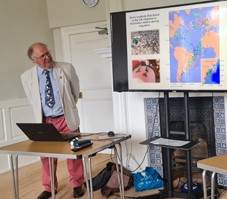
Ascension Island, a remote volcanic island located in the South Atlantic Ocean, is a fascinating and unique place both in terms of its geography and history. Part of the British Overseas Territory of Saint Helena, Ascension, and Tristan da Cunha, it lies about 1,600 kilometres from the coast of Africa and 2,250 kilometres from South America. In 1815 the British garrisoned the island to prevent the French from using it as a base to rescue Napoleon, who was imprisoned on the nearby island of Saint Helena.
Ascension Island is a barren, rocky outcrop, 10 miles by 10 miles, with
its highest point, Green Mountain, reaching an elevation of 859 meters.
This peak is home to a surprising tropical cloud forest, a result of one
of the earliest large-scale ecological experiments where, in the 19th
century, botanists introduced plants from different parts of the world
in an effort to create a more hospitable environment. This has led to
the island’s unique ecosystem, with introduced species thriving
alongside native flora and fauna.
Its Turtle Beach is the most important nesting site for green turtles in the Atlantic.Nowadays Ascension Island is the centre of the Atlantic’s 3rd biggest MPA (Marine Protection Area).
Above all, the island is a very important seabird staging and nesting location including birds in transit to and from the UK.
There are 11 species of seabirds. However, no safe place for birds nesting because of feral cats and rat infestation. A small offshore islet is the only safe nesting place. In addition Mynabirds are causing huge damage. They peck seven or eight eggs for each one they actually consume.
Dr Hughes’ research concentrated on the Sooty Tern. Their
population has crashed from about 3 million in the 1950s to nowadays
350,000. Over a 25-year period he has contributed to identifying the
causes and remedies.
Progress has been made by eradicating feral cats at big expense.
However, this has exacerbated the rat problem. Due to the absence of
cats rats can now feed on average on two Tern breeding cycles.
Eliminating the rat population will be a multi-million Pound challenge.

Benjamin Ferrey – Forgotten Giant of Architecture
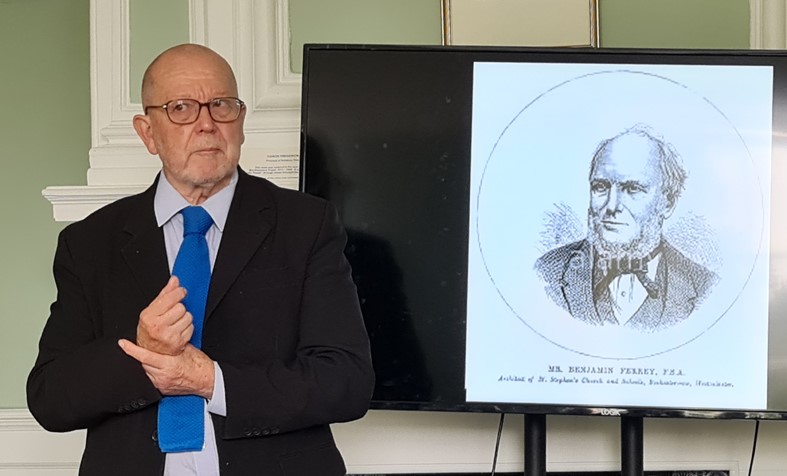
Benjamin Ferrey (1810–1880) was an influential English Gothic Revival architect and a close associate of
prominent figures in 19th-century architecture, such as Augustus Pugin.
Probus Club of Sarum was delighted to welcome Dr Francis Burroughes,teacher, organist, church warden and connoisseur of Ferrey’s work.
Ferrey was born in Christchurch, Dorset, England.
He studied at Christ's Hospital and later apprenticed under the renowned
architect Augustus Pugin, a driving force in the Gothic Revival
movement. Dr Burroughes’ lecture concentrated largely on
Ferrey’s prolific work throughout Wessex.
In 1834, Ferrey began his architectural practice in
London. He quickly made a name for himself by focusing on the
restoration and construction of churches, a popular architectural
endeavour in the 19th century, in line with the Ecclesiological Movement
that sought to revive medieval Gothic church designs. Ferrey's work was
often characterized by a deep appreciation for historical styles,
particularly the Gothic.
Ferrey's portfolio includes many important
ecclesiastical and secular buildings:
1. Church Restorations: He was known
for restoring numerous medieval churches, most notably the restoration
of Wells Cathedral in Somerset, a project that highlighted his
skill in handling complex historical structures with sensitivity and
precision. A total of more than 480 churches are known to have
been built or restored by Ferrey
2. All Saints' Church,
Windsor: One of his significant new church projects, this building
showcases Ferrey's mastery of Gothic design elements, such as pointed
arches, ribbed vaults, and decorative stonework.
3. Secular Architecture: Ferrey has
also designed and/or restored many secular buildings, including manor
houses and public structures, with a Gothic Revival approach.
Examples are the Market Cross at Glastonbury,
Tyntesfield, designed with one of his pupils, Bagshot Park in Berkshire,
Dorchester Corn Exchange etc. In fact, he designed so many buildings in
Dorchester that it has been referred to as “Ferrey Town”. He was also
commissioned with the original layout of Bournemouth.
Professional Recognition:
Ferrey was a founding member of the Royal
Institute of British Architects (RIBA) and contributed to the
architectural discourse of his time. His dedication to the Gothic
Revival movement and ecclesiastical architecture earned him significant
recognition in architectural circles. He maintained an architectural
practice for nearly five decades, during which he influenced the spread
of the Gothic style across England.
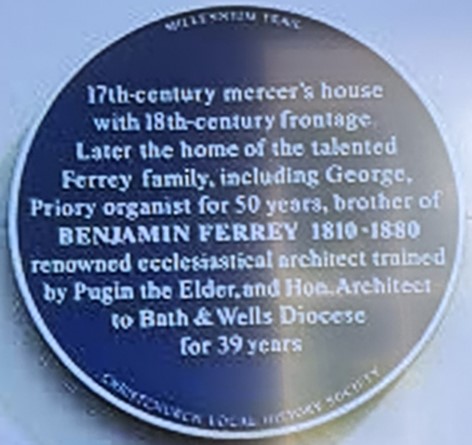
Personal Life and Legacy
Ferrey was known to have a close professional and
personal relationship with the Pugin family, particularly Augustus
Pugin, who significantly influenced his early career. Ferrey died in
1880, leaving behind a body of work that continued to inspire architects
of subsequent generations.
His contributions to the field of architecture are
documented in various architectural journals of his time and through his
involvement with RIBA.
During the subsequent discussion Dr. Burroughes pointed out that Ferrey practiced
at a time when architects had to do “the whole job” from finding and
acquiring the sites to procuring the right material, no clerks of work,
no surveyors or structural engineers. This must have resulted in an
unbelievable workload much of it accomplished during train journeys
crisscrossing the country.
250 Years fighting the Americans – Probus
Club of Sarum
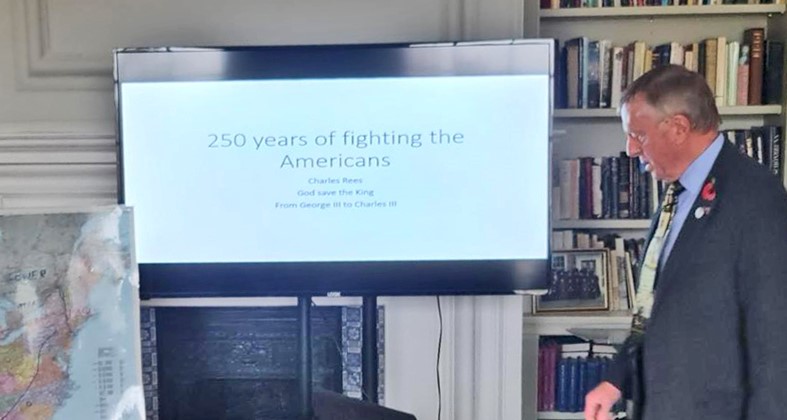
was delighted to welcome Dr Charles Rees, retired GP from Christchurch,
to its Friday lecture. After his retirement Charles Rees developed a
keen interest in the American Civil War. Over the last 30 year this
brought him into close contact with many American friends as well as the
country at large.
He had
to realise that, very different from the conventional prevailing
narrative, there is one big bogeyman throughout America’s history: Great
Britain. He shared this perspective through his well-illustrated
lecture.
He
traced his theme back to the French and Indian wars 1775 to 1783. Far
from being arbitrary, the Boston taxation row (tea party) had its origin
in the Crown’s need to recoup some of the cost in supporting the
Colonies’ war costs.
The end
result was the war of independence where the British Army was repeatedly
defeated for the first time after many decades. The Red Coats were
unable to cope with the freewheeling type of fighting rather than the
European “set battles”. This despite many Americans, especially in the
Carolinas, staying loyal to the Crown. The same was true of the French
colonists.
Tensions rose due to British interference
with American trade, impressment of American sailors, and British
support for Native American resistance against American expansion.
The war
saw invasions on both sides, including the burning of Washington, D.C.,
by British forces in 1814, and key battles like the Battle of Lake Erie
and the Battle of New Orleans. The war's most famous incident was the
U.S. defence of Fort McHenry, inspiring "The Star-Spangled Banner."
The
Treaty of Ghent (1814) ended the war in a stalemate, with no major
territorial changes.
These
disputes were eventually resolved peacefully through diplomacy and
negotiation.
In the
unfolding civil war Great Britain officially took a stance of
neutrality. Although, its economic, political, and diplomatic actions
had significant implications for both the Union and the Confederate
States.
While
Britain considered siding with the South to secure its cotton needs, it
ultimately found alternative cotton sources in Egypt and India.
Although, some British merchants did engage in trade with the
Confederacy through blockade-running operations, supplying the South
with goods in exchange for cotton.
The
Alabama Claims: The Confederacy commissioned several warships built in
British shipyards, including the *CSS Alabama*, which inflicted
significant damage on Union merchant ships. Although Britain ultimately
stopped further construction of such ships, the U.S. filed claims
against Britain after the war for damages, leading to the 1872
international arbitration and a financial settlement known as the
"Alabama Claims."
Dr
Rees pointed out that while relations became peaceful, they were never
“special”. In fact, he maintained US entry into WWI was much more driven
by sympathy for France than for Britain. During WWII the “special
relationship” was very much a construct of politics. One example he
cited: The terms of lend lease were strictly commercial, resulting in GB
paying down huge amounts with interest until 2006! Nowadys Americans
view Britain as just one of several medium sized states, about the size
of Michigan!
For more previous meetings 2019-21 2021 2021-2 2022 2023 2025
For more recent talks click here